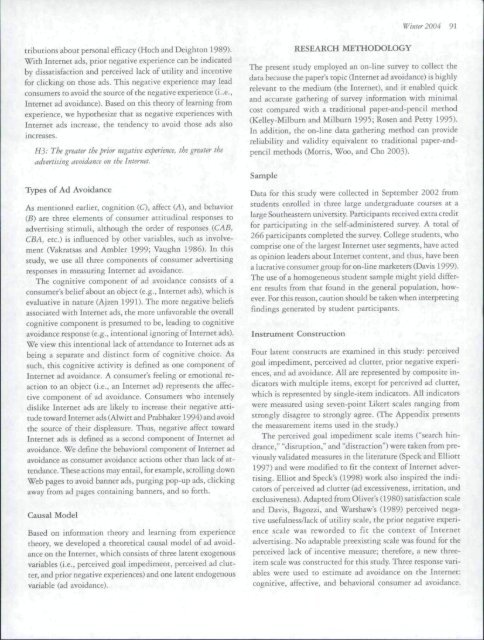why do people avoid advertising on the internet? - Many Too Many
why do people avoid advertising on the internet? - Many Too Many
why do people avoid advertising on the internet? - Many Too Many
Create successful ePaper yourself
Turn your PDF publications into a flip-book with our unique Google optimized e-Paper software.
Winter 2004 91<br />
tributi<strong>on</strong>s about pers<strong>on</strong>al efficacy (Hoch and Deight<strong>on</strong> 1989).<br />
With Internet ads, prior negative experience can be indicated<br />
by dissatisfacti<strong>on</strong> and perceived lack of utility and incentive<br />
for clicking <strong>on</strong> those ads. This negative experience may lead<br />
c<strong>on</strong>sumers to <str<strong>on</strong>g>avoid</str<strong>on</strong>g> <strong>the</strong> source of <strong>the</strong> negative experience (i..e.,<br />
Internet ad <str<strong>on</strong>g>avoid</str<strong>on</strong>g>ance). Based <strong>on</strong> this <strong>the</strong>ory of learning from<br />
experience, we hypo<strong>the</strong>size that as negative experiences with<br />
Internet ads increase, <strong>the</strong> tendency to <str<strong>on</strong>g>avoid</str<strong>on</strong>g> those ads also<br />
increases.<br />
H3: The greater <strong>the</strong> prior negative experience, <strong>the</strong> greater <strong>the</strong><br />
<str<strong>on</strong>g>advertising</str<strong>on</strong>g> <str<strong>on</strong>g>avoid</str<strong>on</strong>g>ance <strong>on</strong> <strong>the</strong> Internet.<br />
RESEARCH METHODOLOGY<br />
The present study employed an <strong>on</strong>-line survey to collect <strong>the</strong><br />
data because <strong>the</strong> paper's topic (Internet ad <str<strong>on</strong>g>avoid</str<strong>on</strong>g>ance) is highly<br />
relevant to <strong>the</strong> medium (<strong>the</strong> Internet), and it enabled quick<br />
and accurate ga<strong>the</strong>ring of survey informati<strong>on</strong> with minimal<br />
cost compared with a traditi<strong>on</strong>al paper-and-pencil method<br />
(Kelley-Milburn and Milburn 1995; Rosen and Petty 1995),<br />
In additi<strong>on</strong>, <strong>the</strong> <strong>on</strong>-line data ga<strong>the</strong>ring method can provide<br />
reliability and validity equivalent to traditi<strong>on</strong>al paper-andpencil<br />
methods (Morris, Woo, and Cho 2003).<br />
Sample<br />
Types of Ad Avoidance<br />
As menti<strong>on</strong>ed earlier, cogniti<strong>on</strong> (C), affect {A), and behavior<br />
{B) are three elements of c<strong>on</strong>sumer attitudinal resp<strong>on</strong>ses to<br />
<str<strong>on</strong>g>advertising</str<strong>on</strong>g> stimuli, although <strong>the</strong> order of resp<strong>on</strong>ses {CAB,<br />
CBA, etc.) is influenced by o<strong>the</strong>r variables, such as involvement<br />
(Vakratsas and Ambler 1999; Vaughn 1986). In this<br />
study, we use all three comp<strong>on</strong>ents of c<strong>on</strong>sumer <str<strong>on</strong>g>advertising</str<strong>on</strong>g><br />
resp<strong>on</strong>ses in measuring Internet ad <str<strong>on</strong>g>avoid</str<strong>on</strong>g>ance.<br />
The cognitive comp<strong>on</strong>ent of ad <str<strong>on</strong>g>avoid</str<strong>on</strong>g>ance c<strong>on</strong>sists of a<br />
c<strong>on</strong>sumer's belief about an object (e.g., Internet ads), which is<br />
evaluative in nature (Ajzen 1991). The more negative beliefs<br />
associated with Internet ads, <strong>the</strong> more unfavorable <strong>the</strong> overall<br />
cognitive comp<strong>on</strong>ent is presumed to be, leading to cognitive<br />
<str<strong>on</strong>g>avoid</str<strong>on</strong>g>ance resp<strong>on</strong>se (e.g., intenti<strong>on</strong>al ignoring of Internet ads).<br />
We view this intenti<strong>on</strong>al lack of attendance to Internet ads as<br />
being a separate and distinct form of cognitive choice. As<br />
such, this cognitive activity is defmed as <strong>on</strong>e comp<strong>on</strong>ent of<br />
Internet ad <str<strong>on</strong>g>avoid</str<strong>on</strong>g>ance. A c<strong>on</strong>sumer's feeling or emoti<strong>on</strong>al reacti<strong>on</strong><br />
to an object (i.e., an Internet ad) represents <strong>the</strong> affective<br />
comp<strong>on</strong>ent of ad <str<strong>on</strong>g>avoid</str<strong>on</strong>g>ance. C<strong>on</strong>sumers who intensely<br />
dislike Internet ads are likely to increase <strong>the</strong>ir negative attitude<br />
toward Internet ads (Alwitt and Prabhaker 1994) and <str<strong>on</strong>g>avoid</str<strong>on</strong>g><br />
<strong>the</strong> source of <strong>the</strong>ir displeasure. Thus, negative affect toward<br />
Internet ads is defmed as a sec<strong>on</strong>d comp<strong>on</strong>ent of Internet ad<br />
<str<strong>on</strong>g>avoid</str<strong>on</strong>g>ance. We defme <strong>the</strong> behavioral comp<strong>on</strong>ent of Internet ad<br />
<str<strong>on</strong>g>avoid</str<strong>on</strong>g>ance as c<strong>on</strong>sumer <str<strong>on</strong>g>avoid</str<strong>on</strong>g>ance acti<strong>on</strong>s o<strong>the</strong>r than lack of actendance.<br />
These acti<strong>on</strong>s may entail, for example, scrolling <str<strong>on</strong>g>do</str<strong>on</strong>g>wn<br />
Web pages to <str<strong>on</strong>g>avoid</str<strong>on</strong>g> banner ads, purging pop-up ads, clicking<br />
away from ad pages c<strong>on</strong>taining banners, and so fiarth.<br />
Causal Model --<br />
Based <strong>on</strong> informati<strong>on</strong> <strong>the</strong>ory and learning from experience<br />
<strong>the</strong>ory, we developed a <strong>the</strong>oretical causal model of ad <str<strong>on</strong>g>avoid</str<strong>on</strong>g>ance<br />
<strong>on</strong> <strong>the</strong> Internet, which c<strong>on</strong>sists of three latent exogenous<br />
variables (i.e., perceived goal impediment, perceived ad clutter,<br />
and prior negative experiences) and <strong>on</strong>e latent en<str<strong>on</strong>g>do</str<strong>on</strong>g>genous<br />
variabie (ad <str<strong>on</strong>g>avoid</str<strong>on</strong>g>ance).<br />
1<br />
Data for this study were collected in September 2002 from<br />
students enrolled in three large undergraduate courses at a<br />
large Sou<strong>the</strong>astern university. Participants received extra credit<br />
for participating in <strong>the</strong> self-administered survey. A total of<br />
266 participants completed <strong>the</strong> survey. College students, who<br />
comprise <strong>on</strong>e of <strong>the</strong> largest Internet user segments, have acted<br />
as opini<strong>on</strong> leaders about Internet c<strong>on</strong>tent, and thus, have been<br />
a lucrative c<strong>on</strong>sumer group for <strong>on</strong>-line marketers (Davis 1999).<br />
The use of a homogeneous student sample might yield different<br />
results from that found in che general populati<strong>on</strong>, however.<br />
For this reas<strong>on</strong>, cauti<strong>on</strong> should be taken when interpreting<br />
findings generated by student participants.<br />
Instrument C<strong>on</strong>structi<strong>on</strong><br />
Four latent c<strong>on</strong>structs are examined in this study: perceived<br />
goal impediment, perceived ad clutter, prior negative experiences,<br />
and ad <str<strong>on</strong>g>avoid</str<strong>on</strong>g>ance. All are represented by composite indicators<br />
with multiple items, except for perceived ad clutter,<br />
which is represented by single-item indicators. All indicators<br />
were measured using seven-point Likert scales ranging from<br />
str<strong>on</strong>gly disagree to str<strong>on</strong>gly agree. (The Appendix presents<br />
<strong>the</strong> measurement items used in <strong>the</strong> study.)<br />
The perceived goal impediment scale items ("search hindrance,"<br />
"disrupti<strong>on</strong>," and "distracti<strong>on</strong>") were taken from previously<br />
validated measures in <strong>the</strong> literature (Speck and Elliott<br />
1997) and were modified to fit <strong>the</strong> c<strong>on</strong>text of Internet <str<strong>on</strong>g>advertising</str<strong>on</strong>g>.<br />
Elliot and Specks (1998) work also inspired <strong>the</strong> indicators<br />
of perceived ad clutter (ad excessiveness, irritati<strong>on</strong>, and<br />
exclusiveness). Adapted from Oliver's (1980) satisfacti<strong>on</strong> scale<br />
and Davis, Bagozzi, and Warshaw's (1989) perceived negative<br />
usefulness/lack of utility scale, <strong>the</strong> prior negative experience<br />
scale was reworded to fit <strong>the</strong> c<strong>on</strong>text of Internet<br />
<str<strong>on</strong>g>advertising</str<strong>on</strong>g>. No adaptable preexisting scale was found for <strong>the</strong><br />
perceived lack of incentive measure; <strong>the</strong>refore, a new threeitem<br />
scale was c<strong>on</strong>structed for this study. Three resp<strong>on</strong>se variables<br />
were used to estimate ad <str<strong>on</strong>g>avoid</str<strong>on</strong>g>ance <strong>on</strong> <strong>the</strong> Internet:<br />
cognitive, affective, and behavioral c<strong>on</strong>sumer ad <str<strong>on</strong>g>avoid</str<strong>on</strong>g>ance.


